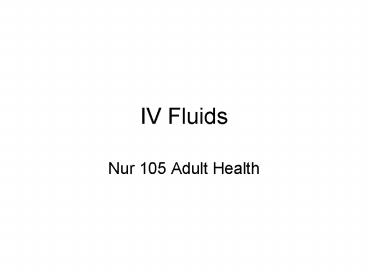IV Fluids - PowerPoint PPT Presentation
1 / 40
Title: IV Fluids
1
IV Fluids
- Nur 105 Adult Health
2
Learning Objectives
- Identify sources of law.
- Define Legal Terms
- Describe the difference between standards of
practice and standards of care.
3
Sources of Law
Constitution Law
Statues Law
Administrative Law
Common Law
4
Legal Terms
- Criminal
- Civil
- Tort
- Intentional/unintentional
- Negligent and Malpractice
5
Standards of Practice and Care
- Standards of Practice
- Standards of Care
- Breach of Duty
- I.V. Nurses Role as Expert Witness
6
Factors to Reduce RisksRisk Management
- Informed consent
- Unusual Occurrence Report (Incident Report)
- Documentation
7
Nursing Competency inIV Therapy
- Competency Standards
- Accountability
- Communication
- Collaboration
- Autonomy
- Competency Model
- Cognitive, Psychomotor, Evaluation
8
Occupational Risks
- Physical Hazards
- Needlestick injuries, abrasions and contusions,
chemical exposure, latex allergy - Biologic Hazards
9
Summary
10
Infection Control Meaures
- Nur 105 Adult Health
11
Learning Objectives
- Describe the purpose and components of the immune
systems. - Identify basic principles in infection control.
- Define the six chains of infection.
- Describe methods to break the chains of
infection. - Describe the causes for infusion-related
infections. - State measures to prevent and treat infections.
12
Immune System
- The Body System that protects the body from
invasion of pathogens.
13
The Immune SystemsOrgans
- Primary
- Thymus and Bone Marrow
- Secondary
- Lymph Nodes, Liver, Lungs
- Spleen, Peyers patches, appendix and Tonsils and
adenoids
14
Immune Systems Defense Mechanisms
- Nonspecific Immune Responses
- Skin, mucous membranes, epiglottis, respiratory
tract, sphincters - Tears, gastric acidity, vaginal secretions
- Lacrimation, intestinal peristalsis,urinary flow
15
Immune Systems Defense Mechanisms
- Specific Immune Responses
- Active acquired and Passive acquired
- Leukocytes
- B and T Lymphocytes
- Immunglobulins
- Phagocytic cells
- Complement system
16
Immune Systems Defense Mechanisms
- Impaired Host Resistence
- Primary immunodeficiency disorders
- Secondary immunodeficiency disorders
17
Principles of Infection Control(Epideminology)
- Colonization
- Dissemination
- Nosocomial
18
Chains of Infection
19
Break the Chains of Infection
- New Methods microbiology and epideminology
- Survelience or Monitoring Quality Improvement
Programs and Risk Management - Pharmacology Treatment
- Stage 1
- Stage 2
- Emporiatrics
20
IV Related InfectionsSources of Catheter-Related
- Skin Organisms
- Contamination of Catheter Hub
- Contaminated Infusate
- Contaminated Device (prior to insertion)
- Hematogenous
- Clinical Manifestations
- Cellulitis/Phlebitis warmth, swelling,
erythema, pain, discharge (serosanguineous or
purulent)
21
IV Related InfectionsRisk Factors
- Host
- Hematogenesis
- Provider
- Catheter
- Infusate Fluids
22
Treatment of Infections
- Catheter Antibiotics
- Infusate-Related
- Mechanism of contamination
- manufacturer
- during infusion
- Duration and frequent interruption or
manipulation of access devices (ports)
23
Treatment of InfectionPrevention and Treatment
- Inspect All Infusates
- Before use check fluid for leaks, expiration
dates, color, consistency - Preparation
- Aseptic Techniques
- Periodic Replacement of Administration Set
- Monitor adjunct devices
- Assess for infections
- Obtain cultures
- CDC Precauations
- Universal
- Transmission-Based
- Airborne
- Droplet
- Contact
- Hand Hygiene
- Skin Antiseptics
- Catheter site dressings
- Sutures or sutureless
- Topical Antimicrobial ointments
- Antimicrobial catheters/cuffs
- Anticoagulants and antibiotic locks
24
Summary
25
Parenteral Solutions
- Chapter 5
26
Purposes of IV Therapy
- Maintenance
- Replacement
- Restoration
27
Components of Parenteral Solutions
- Water
- Glucose
- Amino Acids
- Vitamins
- Electrolytes
- PH
28
Osmolarity of Parenteral Solutions
- Isotonic
- Hypotonic
- Hypertonic
29
Types of Parenteral Solutions
- Crystalloid
- Dextrose
- Sodium Chloride
- Dextrose with Sodium Chloride
- Hydrating solutions
- Electrolytes Fluids
- Ringers/Lactated Ringers
- Alkalizing/Acidifying
- Potassium Chloride
- Colloid
- Dextran
- Albumin
- Mannitol
- Hetastarch
30
Nursing Role
- Check MD order
- Check IV fluid three times 5 RS
- Check IV fluid for
- Color,
- Consistency,
- Expiration date,
- Leaks
- Monitor IV Fluids every hour
- Check IV site
- No catch ups
- Check compatibility
- Use aseptic technique
31
Summary
32
Parenteral Equipment
33
Infusion Container
- Glass
- Plastic
- Use-Activated Containers
34
Basic Administration Sets
- Single line or Y sets
- Spike/piercing pin
- Flange
- Drop orifice
- Drop chamber
- Tubing
- Roller Clamp
- Injection ports
- Backcheck valve
- Hub
- Final filter
- Primary/Secondary
35
Administration Sets
- Primary Y
- Pump Specific Administration set
- Lipid Administration
- Nitroglycerin
36
IV Accessory Devices
- Filters
- Different sizes (170 micorns to 0.22)
- Different locations( inline)
- Different types ( depth, membrane , blood
administration) - Follow agency policy and procedures
- Extension tubing
- Adapters and Connectors (used at injection site)
37
Accessory Devices
- Stopcocks
- Needleless System
38
Peripheral Infusion Devices
- Scalp vein needles (butterfly) short therapy
- Over-the-Needle Catheter most commonly used
14-22 gauge - Thin wall, flashback chamber, wings, color coding
for sizes - Dual Lumen
- Through the-Needle Catheter
- Midline Catheter
39
Infusion Regulation Devices
- Mechanical Gravity Devices
- Dial A- Flow
- Electronic Infusion Devices
- Controller
- Positive-Pressure Infusion Pumps
- Volumetric Pumps
- Peristalic Pumps
- Syringe Pumps/PCA
- Ambulatory Pump
- Multi/Dual Channel Pumps
40
Summary































